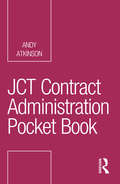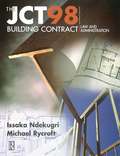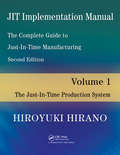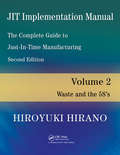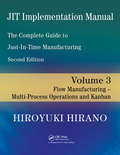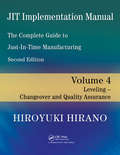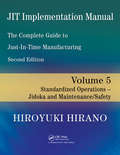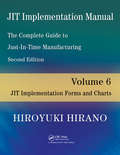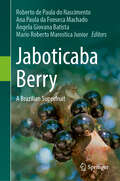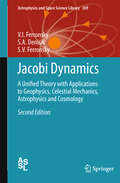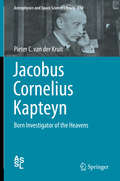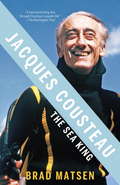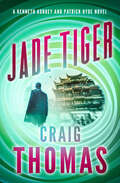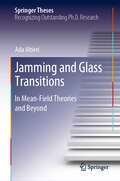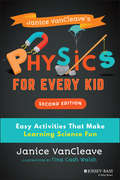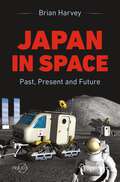- Table View
- List View
JCT Contract Administration Pocket Book (Routledge Pocket Books)
by Andrew AtkinsonSuccessfully managing your JCT contracts is a must, and this handy reference is the swiftest way to doing just that. Making reference to best practice throughout, the JCT Standard Building Contract SBC/Q and DB used as examples to take you through all the essential contract administration tasks, including: <P><P> Procurement paths <P><P> Payment <P><P> Final accounts <P><P> Progress, completion and delay <P><P> Subcontracting <P><P> Defects and quality control <P><P> In addition to the day to day tasks, this also gives you an overview of what to expect from common sorts of dispute resolution under the JCT, as well as a look at how to administer contracts for BIM-compliant projects. This is an essential starting point for all students of construction contract administration, as well as practitioners needing a handy reference to working with the JCT.
JCT98 Building Contract: Law and Administration
by Issaka Ndekugri Michael RycroftThe Joint Contracts Tribunal's Standard Form of Building Contract is the most common contract used in the UK to procure building work. Understanding it is a core part of any construction student's degree and a vital part of the working life of professionals in the construction industry. 'The JCT98 Building Contract' works through the contract systematically explaining it in easy-to-follow language, covering all contract issues thoroughly and illustrating with case law examples the current situation and latest amendments. It is ideal reading for both the student of construction and the professional seeking to update their knowledge.
JIRA Essentials Third Edition
by Patrick Li<P><P>Use the features of JIRA to manage projects and effectively handle bugs and software issues <P><P>About This Book <P><P>Install, build, and implement your own Atlassian JIRA instance to track and manage projects <P><P>Customize your JIRA with data capture and display, workflow design, and security to suit your requirements <P><P>Step-by-step exercises at the end of each chapter for you to try out and reinforce your skills <P><P>Who This Book Is For <P><P>If you wish to develop your practical skills with JIRA in order to install, use, and manage your projects, then this is the perfect book for you. You need to be familiar with software project management and basic computer operations, specifically the system on which you will use JIRA. <P><P>What You Will Learn <P><P>Learn about the JIRA architecture and essential components that help you prepare for deployments <P><P>Understand JIRA from both an end users and administrator's perspective <P><P>Design and implement custom forms to capture information with custom fields, screens, and validation rules <P><P>Create and design custom workflows with complex validation logic and business rules <P><P>Secure JIRA data from unauthorized access <P><P>Notify users with updates using automated e-mail rules <P><P>Search, report on, and analyze your project progress <P><P>Manage and run projects with Agile methodologies <P><P>In Detail <P><P>Atlassian JIRA is an enterprise issue tracker system. One of its key strengths is its ability to adapt to the needs of the organization, ranging from building Atlassian application interfaces to providing a platform for add-ons to extend JIRA's capabilities. <P><P>JIRA Essentials, Third Edition provides a comprehensive explanation covering all major features of Atlassian JIRA, broken down and organized in logical order. The book starts by showing you how to set up your own JIRA instance before introducing you to key features and concepts such as business processes, workflows, e-mails, and notifications. This book will show you how to develop software more efficiently by planning, designing, and customizing your own JIRA implementation. At the end of each chapter, you will have the opportunity to put your newly acquired knowledge into practice by following a step-by-step, hands-on project that you will build throughout the book.
JIT Implementation Manual -- The Complete Guide to Just-In-Time Manufacturing: Volume 1 -- The Just-In-Time Production System
by Hiroyuki Hirano"It is a book for manufacturing companies that are fighting desperately for survival and that will go to any length to improve their factories and overcome the obstacles to success. One could even call this book a �bible� for corporate survival."�Hiroyuki Hirano Known as the JIT bible in Japan, JIT Implementation Manual � The Complete Guide t
JIT Implementation Manual -- The Complete Guide to Just-In-Time Manufacturing: Volume 2 -- Waste and the 5S's
by Hiroyuki Hirano"It is a book for manufacturing companies that are fighting desperately for survival and that will go to any length to improve their factories and overcome the obstacles to success. One could even call this book a �bible� for corporate survival."�Hiroyuki Hirano Known as the JIT bible in Japan, JIT Implementation Manual � The Complete Guide t
JIT Implementation Manual -- The Complete Guide to Just-In-Time Manufacturing: Volume 3 -- Flow Manufacturing -- Multi-Process Operations and Kanban
by Hiroyuki Hirano Raif Notarangelo"It is a book for manufacturing companies that are fighting desperately for survival and that will go to any length to improve their factories and overcome the obstacles to success. One could even call this book a �bible� for corporate survival."�Hiroyuki Hirano Known as the JIT bible in Japan, JIT Implementation Manual � The Complete Guide t
JIT Implementation Manual -- The Complete Guide to Just-In-Time Manufacturing: Volume 4 -- Leveling -- Changeover and Quality Assurance
by Donald B. Rubin Hiroyuki Hirano Hal S. Stern Andrew Carlin"It is a book for manufacturing companies that are fighting desperately for survival and that will go to any length to improve their factories and overcome the obstacles to success. One could even call this book a �bible� for corporate survival."�Hiroyuki Hirano Known as the JIT bible in Japan, JIT Implementation Manual � The Complete Guide t
JIT Implementation Manual -- The Complete Guide to Just-In-Time Manufacturing: Volume 5 -- Standardized Operations -- Jidoka and Maintenance/Safety
by Hiroyuki Hirano"It is a book for manufacturing companies that are fighting desperately for survival and that will go to any length to improve their factories and overcome the obstacles to success. One could even call this book a �bible� for corporate survival."�Hiroyuki Hirano Known as the JIT bible in Japan, JIT Implementation Manual � The Complete Guide t
JIT Implementation Manual -- The Complete Guide to Just-In-Time Manufacturing: Volume 6 -- JIT Implementation Forms and Charts
by Hiroyuki Hirano"It is a book for manufacturing companies that are fighting desperately for survival and that will go to any length to improve their factories and overcome the obstacles to success. One could even call this book a �bible� for corporate survival."�Hiroyuki Hirano Known as the JIT bible in Japan, JIT Implementation Manual � The Complete Guide t
JP Delaney: Three Thrillers in One
by JP DelaneyThe JP Delaney Collection: three gripping and addictive thrillers by the globally bestselling author The Girl Before Enter the world of One Folgate Street and discover perfection . . . but can you pay the price? Jane stumbles on the rental opportunity of a lifetime: the chance to live in a beautiful ultra-minimalist house designed by an enigmatic architect, on condition she abides by a long list of exacting rules. After moving in, she discovers that a previous tenant, Emma, met a mysterious death there - and starts to wonder if her own story will be a re-run of the girl before. As twist after twist catches the reader off guard, Emma's past and Jane's present become inexorably entwined in this tense, page-turning portrayal of psychological obsession. Believe MeClaire Wright likes to play other people. A British drama student, in New York without a green card, Claire takes the only job she can get: working for a firm of divorce lawyers, posing as an easy pick-up in hotel bars to entrap straying husbands. When one of her targets becomes the subject of a murder investigation, the police ask Claire to use her acting skills to help lure their suspect into a confession. But right from the start, she has doubts about the part she's being asked to play. Is Patrick Fogler really a killer . . . Or the only decent husband she's ever met? And is there more to this set-up than she's being told? And that's when Claire realises she's playing the deadliest role of her life . . .The Perfect Wife"There's something I have to explain, my love," he says, taking your hand in his. "That wasn't a dream. It was an upload." Abbie wakes in a hospital bed with no memory of how she got there. The man by her side explains that he's her husband. He's a titan of the tech world, the founder of one of Silicon Valley's most innovative startups. He tells Abbie she's a gifted artist, a doting mother to their young son, and the perfect wife. Five years ago, she suffered a terrible accident. Her return from the abyss is a miracle of science, a breakthrough in artificial intelligence that has taken him half a decade to achieve. But as Abbie pieces together memories of her marriage, she begins questioning her husband's motives - and his version of events. Can she trust him when he says he wants them to be together for ever? And what really happened to her, half a decade ago?
JUNOS Enterprise Switching: A Practical Guide to JUNOS Switches and Certification
by Doug Marschke Harry ReynoldsJUNOS Enterprise Switching is the only detailed technical book on Juniper Networks' new Ethernet-switching EX product platform. With this book, you'll learn all about the hardware and ASIC design prowess of the EX platform, as well as the JUNOS Software that powers it. Not only is this extremely practical book a useful, hands-on manual to the EX platform, it also makes an excellent study guide for certification exams in the JNTCP enterprise tracks. The authors have based JUNOS Enterprise Switching on their own Juniper training practices and programs, as well as the configuration, maintenance, and troubleshooting guidelines they created for their bestselling companion book, JUNOS Enterprise Routing. Using a mix of test cases, case studies, use cases, and tangential answers to real-world problems, this book covers:Enterprise switching and virtual LANs (VLANs)The Spanning tree protocol and why it's neededInter-VLAN routing, including route tables and preferencesRouting policy and firewall filtersSwitching security, such as DHCP snoopingTelephony integration, including VLAN voicePart of the Juniper Networks Technical Library, JUNOS Enterprise Switching provides all-inclusive coverage of the Juniper Networks EX product platform, including architecture and packet flow, management options, user interface options, and complete details on JUNOS switch deployment.
Jaboticaba Berry: A Brazilian Superfruit
by Roberto de Paula do Nascimento Ana Paula da Fonseca Machado Ângela Giovana Batista Mario Roberto Marostica JuniorJaboticaba Berry (Plinia spp.), a native fruit from the Brazilian Atlantic Forest, has been associated with several benefits for the prevention or therapy of chronic diseases due to its promising set-up of antioxidants and nutrients. Jaboticaba shows a distinguished amount of bioactive compounds when compared to other popular berries, which instigates great interest in pharmaceutical and food usage. The many parts of the berry, but especially the seed and peel by-products, are rich in dietary fibers and phenolic compounds and therefore have been able to counteract the negative implications of obesity, diabetes, inflammation, hepatic complications, and cancers, as shown by experimental studies. The development of new products and alternative therapies calls for the understanding of jaboticaba’s history, occurrence, morphology, nutritional and chemical composition, and industrial usage potential, reunited in this book. Well-founded and cutting-edge Jaboticaba berry: A Brazilian superfruit aims to instigate and inspire researchers, health and academic professionals, food and pharmaceutical scientists, educators, students, and all of those interested in natural products, herbal medicine, innovative alternative therapies, and sustainable use of by-products.
Jackfruit: Botany, Production and Uses (Botany, Production and Uses)
by David Guest Anup K. Bhattacherjee Azimah Hamidon Hamizah Hassan Mohamad Munirah Pradyot K. Pathak Pravat K. Ray Nor E Tajidin Gundappa Baradevanal Jigzcel Divine Bassoy Prakash C. Tripathi Michel Chauvet Phebe Ding Mathala Juliet Gupta C. K. Harshita Ganesan Karunakaran Kundan Kishore Rosmah Murdad Dinh Thi Phuong S. Rajendran Ankita Sahu Hari S. Singh A. Thirugnanavel Mai Van Tri Josephine G. Tangonan M. Arivalagan Chalina K. Beneragama R.M.S. Ruwan Chamara V. Dileep D.M. Samantha Dissanayaka H.M. Prathibhani Kumarihami Asanga D. Nagalla D.K.N. Gamini Pushpakumara T. Sakthivel P. M. Sampath Shyamalamma Subbareddy Valeeta Marina Dsouza H. V. VidyashreeJackfruit (Artocarpus heterophyllus), is a species of tree in the fig, mulberry, and breadfruit family (Moraceae) and is widely esteemed in tropical Asia. The jackfruit tree is well suited to tropical lowlands, and is widely cultivated throughout South and South-East Asia. It is also grown to a limited extent in Australia, USA, East Africa, as well as in Brazil, Mexico and the Caribbean. Producing giant fruits which can reach up to 80kg in size, jackfruit is the largest tree-borne fruit in the world. It is highly versatile, providing food, timber, fuel in addition to medicinal and industrial products. The ripe fruit is sweet and is more often used for desserts. Canned green jackfruit has a mild taste and meat-like texture that lends itself to being called a 'vegetable meat'. Hence, it is growing in popularity due to its use as a vegan meat alternative. The tree is a major component of subsistence and small-farming systems and the fruit often assumes the role of a secondary staple food as well as contributing to the livelihoods of the poor. Despite this, it is still an underutilized crop in many countries. Containing information on jackfruit production technology, postharvest management and processing, this is a valuable resource for researchers in horticulture, plant science, and those interested in sustainable food systems.
Jackrabbit McCabe and the Electric Telegraph
by Leo Espinosa Lucy Margaret RozierThe fastest man in the West meets his match in this deliciously clever original tall tale--perfect for the Common Core classroom. With his extra-long legs, Jackrabbit McCabe can outrun anything on the American frontier: horses, trains, and even twisters. So of course, everyone in the town of Windy Flats always counts on his speed when a message has to get out fast. Then something new comes to town: the telegraph, which can send Morse code messages with the speed of electricity. At first, no one believes the newfangled contraption can deliver a message quicker than Jackrabbit. . . . But in a race between man and machine, who will be left in the dust? An author's note includes information about the invention of the telegraph, a Morse code key, and a riddle written in Morse code for kids to transcribe."A strikingly accomplished debut.... A terrific tall tale about the costs and opportunities of technology." --Publishers Weekly, Starred"Good, quick-moving fun. Kids may marvel that communication existed before the telephone and Internet." --Kirkus ReviewsFrom the Hardcover edition.
Jacobi Dynamics
by S. V. Ferronsky V. I. Ferronsky S. A. DenisikIn their approach to Earth dynamics the authors consider the fundamentals of Jacobi Dynamics (1987, Reidel) for two reasons. First, because satellite observations have proved that the Earth does not stay in hydrostatic equilibrium, which is the physical basis of today's treatment of geodynamics. And secondly, because satellite data have revealed a relationship between gravitational moments and the potential of the Earth's outer force field (potential energy), which is the basis of Jacobi Dynamics. This has also enabled the authors to come back to the derivation of the classical virial theorem and, after introducing the volumetric forces and moments, to obtain a generalized virial theorem in the form of Jacobi's equation. Thus a physical explanation and rigorous solution was found for the famous Jacobi's equation, where the measure of the matter interaction is the energy. The main dynamical effects which become understandable by that solution can be summarized as follows: * the kinetic energy of oscillation of the interacting particles which explains the physical meaning and nature of the gravitation forces; * separation of the shell's rotation of a self-gravitating body with respect to the mass density; difference in angular velocities of the shell rotation; * continuity in changing the potential of the outer gravitational force field together with changes in density distribution of the interacting masses (volumetric center of masses); * the nature of the precession of the Earth, the Moon and satellites; the nature of the rotating body's magnetic field and the generation of the planet's electromagnetic field.As a final result, the creation of the bodies in the Solar System having different orbits was discussed. This result is based on the discovery that all the averaged orbital velocities of the bodies in the Solar System and the Sun itself are equal to the first cosmic velocities of their proto-parents during the evolution of their redistributed mass density. Audience The work is a logical continuation of the book Jacobi Dynamics and is intended for researchers, teachers and students engaged in theoretical and experimental research in various branches of astronomy (astrophysics, celestial mechanics and stellar dynamics and radiophysics), geophysics (physics and dynamics of the Earth's body, atmosphere and oceans), planetology and cosmogony, and for students of celestial, statistical, quantum and relativistic mechanics and hydrodynamics.
Jacobus Cornelius Kapteyn
by Pieter C. van der KruitJacobus C. Kapteyn (1851-1922) was a Dutch astronomer who contributed heavily to major catalogs of star positions, such as the Cape Photographic Durchmusterung and the Harvard-Groningen Durchmusterung, and arranged extensive international collaboration through his Plan of Selected Areas. He contributed to the establishment of statistical astronomy and structure and dynamics of the Sidereal System. All aspects of Kapteyn's life are discussed, from his birth in Barneveld, the Netherlands, to his death in Amsterdam, and his entire resume of scientific achievements in between. Kapteyn had some conflicts with others in his field, especially after the world became divided on how to handle scientific contributions from Germany post-World War I. Both Kapteyn's struggles and achievements are written against the backdrop of both the historical context of the world at that time as well as the scientific one.
Jacques Cousteau: The Sea King
by Brad MatsenIn this balanced biography of Cousteau (1910-1997), Matsen (an author specializing in marine subjects) traces the life and contributions of the renowned marine explorer/filmmaker/ conservationist from his development of the Agua-Lung and undersea photography equipment to his public television documentary series, The Undersea World of Jacques Cousteau, and legal battles between his heirs. The book includes photographs of Cousteau, his two families, well-known ship The Calypso, scientific expeditions, and monument in his hometown in France. Annotation c2010 Book News, Inc. , Portland, OR (booknews. com)
Jade Tiger (The Kenneth Aubrey & Patrick Hyde Series)
by Craig ThomasNew York Times–Bestselling Author of Firefox: At the height of the Cold War, the Berlin Wall may finally fall—but who&’s really pulling the strings? Sir Kenneth Aubrey remembers Wolfgang Zimmerman from a dramatic encounter back in World War II. In the intervening decades, Zimmerman has risen to become a top advisor to the West German chancellor. Thanks to Zimmerman, the prospect of a reunified Germany is now on the horizon. Until he falls ill during an overseas trade visit and begins to babble deliriously—in Russian. That, as they say, is a definite red flag . . . When Aubrey hears the story from a Chinese spy-turned-defector, he&’s unsure whether to believe Zimmerman could be secretly working for the Soviets. To untangle the truth, he and Hyde will have to go all the way to Australia—and face down a team of killers . . . Praise for Craig Thomas&’s thrillers &“High-octane.&” —Daily Express &“Will have you sweating bullets. Thomas misses no tricks, and tension is sustained from first page to last.&” —The New York Times Book Review
James Hutton: The Genius of Time
by Ray PermanDiscover one of the Scottish Enlightenment's brightest stars. Among the giants of the Scottish Enlightenment, the name of James Hutton is overlooked. Yet his Theory of the Earth revolutionised the way we think about how our planet was formed and laid the foundation for the science of geology. He was in his time a doctor, a farmer, a businessman, a chemist yet he described himself as a philosopher – a seeker after truth. A friend of James Watt and of Adam Smith, he was a polymath, publishing papers on subjects as diverse as why it rains and a theory of language. He shunned status and official position, refused to give up his strong Scots accent and vulgar speech, loved jokes and could start a party in an empty room. Yet much of his story remains a mystery. His papers, library and mineral collection all vanished after his death and only a handful of letters survive. He seemed to be a lifelong bachelor, yet had a secret son whom he supported throughout his life. This book uses new sources and original documents to bring Hutton the man to life and places him firmly among the geniuses of his time.
James Lovelock: In Search of Gaia
by John Gribbin Mary GribbinIn 1972, when James Lovelock first proposed the Gaia hypothesis--the idea that the Earth is a living organism that maintains conditions suitable for life--he was ridiculed by the scientific establishment. Today Lovelock's revolutionary insight, though still extremely controversial, is recognized as one of the most creative, provocative, and captivating scientific ideas of our time. James Lovelock tells for the first time the whole story of this maverick scientist's life and how it served as a unique preparation for the idea of Gaia. Drawing on in-depth interviews with Lovelock himself and unprecedented access to his private papers, John and Mary Gribbin paint an intimate and fascinating portrait of a restless, uniquely gifted freethinker. In a lifetime spanning almost a century, Lovelock has followed a career path that led him from chemistry, to medicine, to engineering, to space science. He worked for the British secret service and contributed to the success of the D-Day landings in World War II. He was a medical experimenter and an accomplished inventor. And he was working with NASA on methods for finding possible life on Mars when he struck upon the idea of Gaia, conceiving of the Earth as a vast, living, self-regulating system. Deftly framed within the context of today's mounting global-warming crisis, James Lovelock traces the intertwining trajectories of Lovelock's life and the famous idea it brought forth, which continues to provoke passionate debate about the nature and future of life on our planet.
James Nasmyth: Engineer - an Autobiography
by Samuel Smiles James NasmythAutobiography of the mechanical inventor
Jamming and Glass Transitions: In Mean-Field Theories and Beyond (Springer Theses)
by Ada AltieriThe work described in this book originates from a major effort to develop a fundamental theory of the glass and the jamming transitions. The first chapters guide the reader through the phenomenology of supercooled liquids and structural glasses and provide the tools to analyze the most frequently used models able to predict the complex behavior of such systems. A fundamental outcome is a detailed theoretical derivation of an effective thermodynamic potential, along with the study of anomalous vibrational properties of sphere systems. The interested reader can find in these pages a clear and deep analysis of mean-field models as well as the description of advanced beyond-mean-field perturbative expansions. To investigate important second-order phase transitions in lattice models, the last part of the book proposes an innovative theoretical approach, based on a multi-layer construction. The different methods developed in this thesis shed new light on important connections among constraint satisfaction problems, jamming and critical phenomena in complex systems, and lay part of the groundwork for a complete theory of amorphous solids.
Jane Goodall: The Woman Who Redefined Man
by Dale PetersonA biography of the primatologist that “vividly and significantly enriches our understanding of Goodall”—includes photographs (Booklist, starred review).This essential biography of one of the most influential women of the past century shows how truly remarkable Jane Goodall’s accomplishments have been. Goodall was a secretarial school graduate when Louis Leakey, unable to find someone with more fitting credentials, first sent her to Gombe to study chimpanzees. In this acclaimed work, Dale Peterson details how this young woman of uncommon resourcefulness and pluck would go on to set radically new standards in the study of animal behavior. He vividly captures the triumphs and setbacks of her dramatic life, including the private quest that led to her now-famous activism.Peterson, a longtime Goodall collaborator, has a unique knowledge of his subject. Candid and illuminating, this work will be a revelation even to readers who are familiar with the public Goodall as presented in her own writing.“Peterson provides colorful descriptions of day-to-day life at Gombe and Goodall’s interaction with the chimps, and ably portrays her relationship with Leakey, the National Geographic Society (which sponsored much of her work), her two marriages, her reaction to her celebrity and her ventures as an activist for the well-being of chimpanzees.” —Publishers Weekly“Captures the spirit of a remarkable woman in science.” —Library Journal (starred review)
Janice VanCleave's Physics for Every Kid: Easy Activities That Make Learning Science Fun (Science for Every Kid Series #69)
by Janice VanCleaveIgnite a passion for science in your student or child with these fascinating physics experiments for kids!Janice VanCleave's Physics for Every Kid: Easy Activities That Make Learning Science Fun, 2nd Edition offers new and lively experiments designed to ignite a passion for science in every child. Designed for children of all ages, this book includes high-interest experiments suitable for home learning, science fair participation, and active classrooms.Physics for Every Kid is sure to engage the natural curiousity of children with experiments that stimulate the mind and encourage a foundation in the principles of physics. With common household items, you'll be able to create: Pendulums Air cars Experiments exploring magnets, sound, motion, light, and more This update to the celebrated Janice VanCleave series includes a fresh new look with full-color illustrations and easy-to-understand explanations for each experiment.Perfect for educators and parents of middle school students, Physics for Every Kid can be used at home just for do-it-yourself science fun and in the classroom to build learning experiences that enlighten and entertain students.
Japan In Space: Past, Present and Future (Springer Praxis Books)
by Brian HarveyGuided by genius engineer Hideo Itokawa, Japan’s space program began with small scientific satellites more than 50 years ago. Since then, its space probes have travelled to the Moon, Venus, the asteroids and even a comet. The country launched weathersatellites to warn of typhoons, communications satellites to connect the Japanese archipelago and remote sensing technology to observe the Earth and warn of climate change. Engineering technology satellites became the basis of Japan’s electronic industry as Japanese astronauts flew into space, working on their Kibo module on the International Space Station.Now, Japan is one of Asia’s leading space powers, alongside China and India, vying for influence in the region. Its solid and liquid-fueled rockets are estimated to be among the most advanced and reliable in the world, its technology among the best. This bookexamines the history of Japan’s space program, the country’s current state of development and its future. It describes the extensive infrastructure that has gone into the forging of Japan’s picturesque oceanside launch sites, training centers, testing facilities and tracking stations. This book also outlines the politics of space in Japan, financial difficulties, its space industry, the symbiotic relationship with the United States and the recent sharp change-of-course to invest in military satellites.From the role of influential personalities, such as Hideo Shima and Shinichi Nakasuka, to political leaders, such as Yasuhiro Nakasone and Takeo Kawamura, you will read about how Japan has paved its own star-lit path to space. The future may expect tosend Japanese probes to Mercury and the moons of Mars, all while the first Japanese astronauts set foot on our own Moon and drive innovative rovers across its surface.
